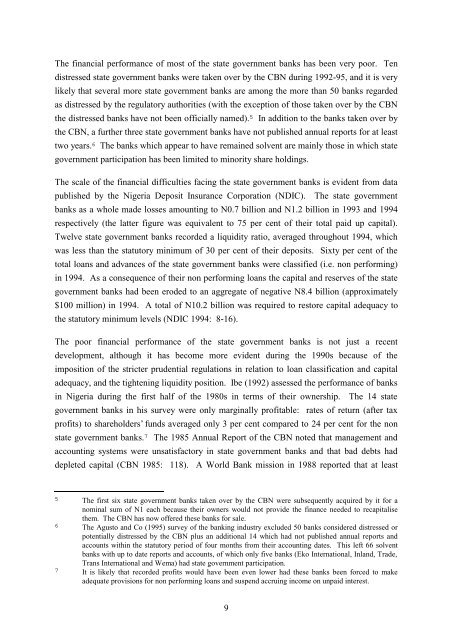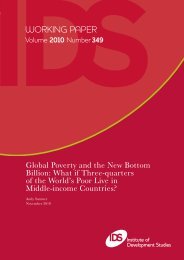the impact of public policy on the banking system in nigeria
the impact of public policy on the banking system in nigeria
the impact of public policy on the banking system in nigeria
You also want an ePaper? Increase the reach of your titles
YUMPU automatically turns print PDFs into web optimized ePapers that Google loves.
The f<strong>in</strong>ancial performance <str<strong>on</strong>g>of</str<strong>on</strong>g> most <str<strong>on</strong>g>of</str<strong>on</strong>g> <str<strong>on</strong>g>the</str<strong>on</strong>g> state government banks has been very poor. Ten<br />
distressed state government banks were taken over by <str<strong>on</strong>g>the</str<strong>on</strong>g> CBN dur<strong>in</strong>g 1992-95, and it is very<br />
likely that several more state government banks are am<strong>on</strong>g <str<strong>on</strong>g>the</str<strong>on</strong>g> more than 50 banks regarded<br />
as distressed by <str<strong>on</strong>g>the</str<strong>on</strong>g> regulatory authorities (with <str<strong>on</strong>g>the</str<strong>on</strong>g> excepti<strong>on</strong> <str<strong>on</strong>g>of</str<strong>on</strong>g> those taken over by <str<strong>on</strong>g>the</str<strong>on</strong>g> CBN<br />
<str<strong>on</strong>g>the</str<strong>on</strong>g> distressed banks have not been <str<strong>on</strong>g>of</str<strong>on</strong>g>ficially named). 5 In additi<strong>on</strong> to <str<strong>on</strong>g>the</str<strong>on</strong>g> banks taken over by<br />
<str<strong>on</strong>g>the</str<strong>on</strong>g> CBN, a fur<str<strong>on</strong>g>the</str<strong>on</strong>g>r three state government banks have not published annual reports for at least<br />
two years. 6 The banks which appear to have rema<strong>in</strong>ed solvent are ma<strong>in</strong>ly those <strong>in</strong> which state<br />
government participati<strong>on</strong> has been limited to m<strong>in</strong>ority share hold<strong>in</strong>gs.<br />
The scale <str<strong>on</strong>g>of</str<strong>on</strong>g> <str<strong>on</strong>g>the</str<strong>on</strong>g> f<strong>in</strong>ancial difficulties fac<strong>in</strong>g <str<strong>on</strong>g>the</str<strong>on</strong>g> state government banks is evident from data<br />
published by <str<strong>on</strong>g>the</str<strong>on</strong>g> Nigeria Deposit Insurance Corporati<strong>on</strong> (NDIC). The state government<br />
banks as a whole made losses amount<strong>in</strong>g to N0.7 billi<strong>on</strong> and N1.2 billi<strong>on</strong> <strong>in</strong> 1993 and 1994<br />
respectively (<str<strong>on</strong>g>the</str<strong>on</strong>g> latter figure was equivalent to 75 per cent <str<strong>on</strong>g>of</str<strong>on</strong>g> <str<strong>on</strong>g>the</str<strong>on</strong>g>ir total paid up capital).<br />
Twelve state government banks recorded a liquidity ratio, averaged throughout 1994, which<br />
was less than <str<strong>on</strong>g>the</str<strong>on</strong>g> statutory m<strong>in</strong>imum <str<strong>on</strong>g>of</str<strong>on</strong>g> 30 per cent <str<strong>on</strong>g>of</str<strong>on</strong>g> <str<strong>on</strong>g>the</str<strong>on</strong>g>ir deposits. Sixty per cent <str<strong>on</strong>g>of</str<strong>on</strong>g> <str<strong>on</strong>g>the</str<strong>on</strong>g><br />
total loans and advances <str<strong>on</strong>g>of</str<strong>on</strong>g> <str<strong>on</strong>g>the</str<strong>on</strong>g> state government banks were classified (i.e. n<strong>on</strong> perform<strong>in</strong>g)<br />
<strong>in</strong> 1994. As a c<strong>on</strong>sequence <str<strong>on</strong>g>of</str<strong>on</strong>g> <str<strong>on</strong>g>the</str<strong>on</strong>g>ir n<strong>on</strong> perform<strong>in</strong>g loans <str<strong>on</strong>g>the</str<strong>on</strong>g> capital and reserves <str<strong>on</strong>g>of</str<strong>on</strong>g> <str<strong>on</strong>g>the</str<strong>on</strong>g> state<br />
government banks had been eroded to an aggregate <str<strong>on</strong>g>of</str<strong>on</strong>g> negative N8.4 billi<strong>on</strong> (approximately<br />
$100 milli<strong>on</strong>) <strong>in</strong> 1994. A total <str<strong>on</strong>g>of</str<strong>on</strong>g> N10.2 billi<strong>on</strong> was required to restore capital adequacy to<br />
<str<strong>on</strong>g>the</str<strong>on</strong>g> statutory m<strong>in</strong>imum levels (NDIC 1994: 8-16).<br />
The poor f<strong>in</strong>ancial performance <str<strong>on</strong>g>of</str<strong>on</strong>g> <str<strong>on</strong>g>the</str<strong>on</strong>g> state government banks is not just a recent<br />
development, although it has become more evident dur<strong>in</strong>g <str<strong>on</strong>g>the</str<strong>on</strong>g> 1990s because <str<strong>on</strong>g>of</str<strong>on</strong>g> <str<strong>on</strong>g>the</str<strong>on</strong>g><br />
impositi<strong>on</strong> <str<strong>on</strong>g>of</str<strong>on</strong>g> <str<strong>on</strong>g>the</str<strong>on</strong>g> stricter prudential regulati<strong>on</strong>s <strong>in</strong> relati<strong>on</strong> to loan classificati<strong>on</strong> and capital<br />
adequacy, and <str<strong>on</strong>g>the</str<strong>on</strong>g> tighten<strong>in</strong>g liquidity positi<strong>on</strong>. Ibe (1992) assessed <str<strong>on</strong>g>the</str<strong>on</strong>g> performance <str<strong>on</strong>g>of</str<strong>on</strong>g> banks<br />
<strong>in</strong> Nigeria dur<strong>in</strong>g <str<strong>on</strong>g>the</str<strong>on</strong>g> first half <str<strong>on</strong>g>of</str<strong>on</strong>g> <str<strong>on</strong>g>the</str<strong>on</strong>g> 1980s <strong>in</strong> terms <str<strong>on</strong>g>of</str<strong>on</strong>g> <str<strong>on</strong>g>the</str<strong>on</strong>g>ir ownership. The 14 state<br />
government banks <strong>in</strong> his survey were <strong>on</strong>ly marg<strong>in</strong>ally pr<str<strong>on</strong>g>of</str<strong>on</strong>g>itable: rates <str<strong>on</strong>g>of</str<strong>on</strong>g> return (after tax<br />
pr<str<strong>on</strong>g>of</str<strong>on</strong>g>its) to shareholders’ funds averaged <strong>on</strong>ly 3 per cent compared to 24 per cent for <str<strong>on</strong>g>the</str<strong>on</strong>g> n<strong>on</strong><br />
state government banks. 7 The 1985 Annual Report <str<strong>on</strong>g>of</str<strong>on</strong>g> <str<strong>on</strong>g>the</str<strong>on</strong>g> CBN noted that management and<br />
account<strong>in</strong>g <strong>system</strong>s were unsatisfactory <strong>in</strong> state government banks and that bad debts had<br />
depleted capital (CBN 1985: 118). A World Bank missi<strong>on</strong> <strong>in</strong> 1988 reported that at least<br />
5 The first six state government banks taken over by <str<strong>on</strong>g>the</str<strong>on</strong>g> CBN were subsequently acquired by it for a<br />
nom<strong>in</strong>al sum <str<strong>on</strong>g>of</str<strong>on</strong>g> N1 each because <str<strong>on</strong>g>the</str<strong>on</strong>g>ir owners would not provide <str<strong>on</strong>g>the</str<strong>on</strong>g> f<strong>in</strong>ance needed to recapitalise<br />
<str<strong>on</strong>g>the</str<strong>on</strong>g>m. The CBN has now <str<strong>on</strong>g>of</str<strong>on</strong>g>fered <str<strong>on</strong>g>the</str<strong>on</strong>g>se banks for sale.<br />
6 The Agusto and Co (1995) survey <str<strong>on</strong>g>of</str<strong>on</strong>g> <str<strong>on</strong>g>the</str<strong>on</strong>g> <strong>bank<strong>in</strong>g</strong> <strong>in</strong>dustry excluded 50 banks c<strong>on</strong>sidered distressed or<br />
potentially distressed by <str<strong>on</strong>g>the</str<strong>on</strong>g> CBN plus an additi<strong>on</strong>al 14 which had not published annual reports and<br />
accounts with<strong>in</strong> <str<strong>on</strong>g>the</str<strong>on</strong>g> statutory period <str<strong>on</strong>g>of</str<strong>on</strong>g> four m<strong>on</strong>ths from <str<strong>on</strong>g>the</str<strong>on</strong>g>ir account<strong>in</strong>g dates. This left 66 solvent<br />
banks with up to date reports and accounts, <str<strong>on</strong>g>of</str<strong>on</strong>g> which <strong>on</strong>ly five banks (Eko Internati<strong>on</strong>al, Inland, Trade,<br />
Trans Internati<strong>on</strong>al and Wema) had state government participati<strong>on</strong>.<br />
7 It is likely that recorded pr<str<strong>on</strong>g>of</str<strong>on</strong>g>its would have been even lower had <str<strong>on</strong>g>the</str<strong>on</strong>g>se banks been forced to make<br />
adequate provisi<strong>on</strong>s for n<strong>on</strong> perform<strong>in</strong>g loans and suspend accru<strong>in</strong>g <strong>in</strong>come <strong>on</strong> unpaid <strong>in</strong>terest.<br />
9

















